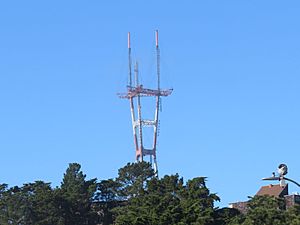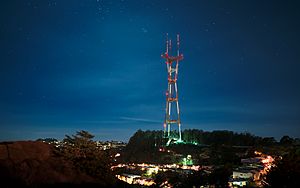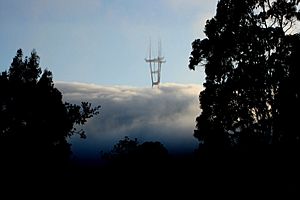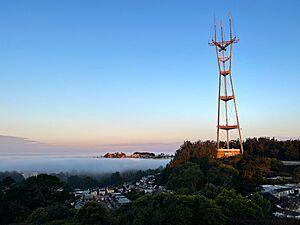Sutro Tower facts for kids
Quick facts for kids Sutro Tower |
|
|---|---|

Sutro Tower viewed from Grandview Park in San Francisco
|
|
| General information | |
| Status | Complete |
| Type | Radio mast |
| Location | San Francisco, California |
| Address | 1 La Avanzada Street Clarendon Heights |
| Coordinates | 37°45′19″N 122°27′10″W / 37.75523°N 122.45284°W |
| Elevation | 254.2 m (834 ft) |
| Construction started | 1971 |
| Completed | July 4, 1973 |
| Owner | Sutro Tower, Inc. |
| Height | |
| Antenna spire | 297.8 m (977 ft) |
| Observatory | on Level 6, 228.8 m (751 ft) above base |
| Dimensions | |
| Other dimensions |
|
| Technical details | |
| Structural system | Truss tower |
| Design and construction | |
| Architect | Furman L. Anderson Jr. |
| Architecture firm |
|
| Renovating team | |
| Engineer | Simpson Gumpertz & Heger |
Sutro Tower is a very tall, three-legged TV and radio tower in San Francisco, California. It stands 297.8 m (977 ft) high! You can find it on a hill between Twin Peaks and Mount Sutro. This makes it a famous part of the city's skyline.
The tower is named after Mount Sutro. A long time ago, in 1948, a mansion on this property was sold to the American Broadcasting Company. This became the first home for their San Francisco TV station, KGO Television. KGO then teamed up with other big TV stations like KTVU, KRON, and KPIX. Together, they built and now own the tower.
Sutro Tower is 297.8 m (977 ft) above the ground. It is also 552 m (1,811 ft) above sea level. This makes it the second tallest structure in San Francisco. Even though it's not in the downtown area, its high location lets it look over all the city's skyscrapers.
Contents
Building the Tower: A Look Back
Before Sutro Tower was built in 1973, watching TV in San Francisco was tricky. The city has many hills, which blocked TV signals. This meant that TV reception was often poor. The new, very tall tower helped fix this problem.
Before the tower, TV transmitters were spread out across the Bay Area. By putting all the main TV station transmitters in one spot, Sutro Tower made things much better. Now, people could point their TV antennas in one direction and get all the stations.
Some people in San Francisco didn't like the tower at first. They worried about how it would look in the city. A famous writer, Herb Caen, even joked that it might "attack the Golden Gate Bridge."
When it was new, the tower's long legs had bright white lights at night. But people complained, and the lights were soon removed. Even with the early complaints, many people now see Sutro Tower as a symbol of the Bay Area. It even appears as a logo for a local guide, SF Station, and in video games like Horizon Forbidden West.
In 2019, some parts of the tower's antennas were changed. This was to install new antennas for a government project called "spectrum repacking." These changes were finished by May 2020.
How Sutro Tower Was Built
Construction of Sutro Tower started in 1971. It was built by Kline Towers. The tower was finished in 1973, and it began sending out signals on July 4, 1973.
Workers used about 3,750 m3 (132,000 cu ft) of concrete for the tower's foundation. The tower itself weighs 1,700 tons (about 3.7 million pounds). To make it safe from earthquakes, two-thirds of its weight is buried underground. This puts its center of gravity 16 feet below ground.
The tower sends signals for ten TV stations and four FM radio stations. It also helps with other communication services.
Sutro Tower Inc. owns the tower. This company is a nonprofit group. It is owned by the four main TV stations that helped build it: KTVU, KRON, KPIX, and KGO. Sutro Tower also rents space to other radio and TV stations in the Bay Area. These include PBS station KQED and independent station KOFY-TV.
Some other major Bay Area TV stations are not located at Sutro Tower. For example, KNTV and KSTS (both owned by NBC) and KICU-TV (a partner of KTVU) transmit from other locations. These stations are based in San Jose and the South Bay. Their locations help them reach those areas best.
Visiting Sutro Tower: What You Can See
Only authorized vehicles can go to the tower site. However, the areas around the tower offer amazing views of San Francisco. There is a platform near the top of the tower. It is 232 m (761 ft) above the ground and 486.2 m (1,595 ft) above sea level.
Only maintenance workers can go up the tower. They use a small, two-person elevator inside one of the tower's legs. The public cannot enter the Sutro Tower property.
On a clear day, you can see the tower from Mount Diablo in the East Bay. Sometimes, when San Francisco is covered in fog, Sutro Tower is the only part of the city you can see sticking out above it.
Stations Broadcasting from Sutro Tower
Television Stations
Many TV stations send their signals from Sutro Tower. Most of these stations also have extra channels called subchannels.
| Callsign | Virtual channel | Physical channel | Affiliation | Online? |
|---|---|---|---|---|
| KTVU | 2 | 26 | Fox | ✔︎ |
| KURK-LD | 3 26 |
3 | REL | ✘ |
| KRON-TV | 4 | 7 | The CW | ✔︎ |
| KPIX | 5 | 29 | CBS | ✔︎ |
| KGO-TV | 7 | 12 | ABC | ✔︎ |
| KQED KQEH |
9
54 |
30 | PBS | ✔︎ |
| KQSL-LD | 17 26 |
4 | REL | ✘ |
| KRCB | 22 | 5 | PBS | ✔︎ |
| KCNS KTNC-TV KEMO-TV |
38 42 50 |
32 | Shop LC (KCNS) TCT (KTNC) ShopHQ (KEMO) |
✔︎ |
| KPYX | 44 | 28 | Independent | ✔︎ |
| KQTA-LD KAAP-LD KTSF KMMC-LD KDTS-LD |
15 24 26 30 52 |
14 | JTV Diya TV Ind. (KTSF) Estrella TV Daystar |
✔︎ |
| KPJK | 60 | 27 | Public Ind. | ✔︎ |
| KFSF | 66 | 34 | UniMás | ✔︎ |
Radio Stations
These FM radio stations also broadcast from Sutro Tower:
- KEXC (92.7)
- KOIT (96.5)
- KSOL (98.9)
- KOSF (103.7)
- KNBR-FM (104.5)
See also
- Lattice tower
- List of tallest freestanding steel structures






